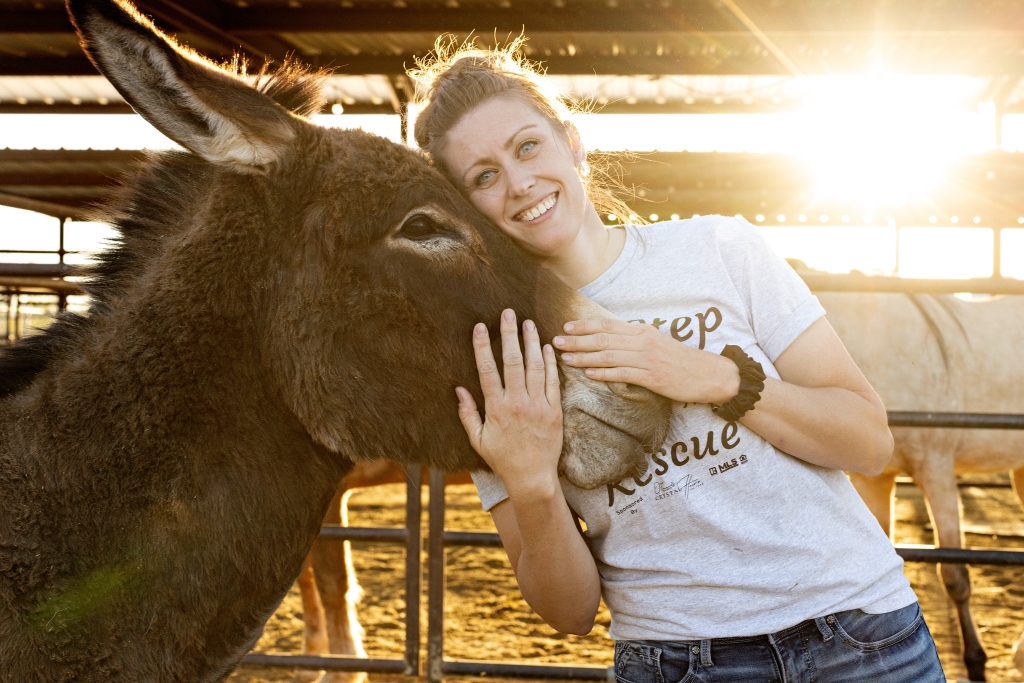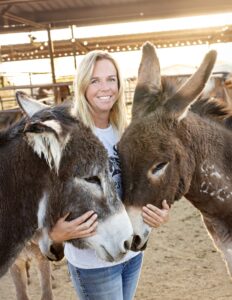Burros in the Balance

One Step’s Mission to Save Arizona’s Wild Donkeys
Writer Joseph J. Airdo // Photography by Loralei Lazurek



Stacie Thomas stands in the morning light at her New River sanctuary, surrounded by a chorus of braying that echoes across the desert landscape. As the founder of One Step Wild Burro and Mustang Rescue, Thomas moves with practiced ease among dozens of long-eared residents — some curious and eager for attention, others hanging back with watchful eyes that still harbor traces of their wild origins.
“They’re really awesome animals, and it’s heartbreaking how a lot of people just don’t care,” Thomas says, scratching the ears of a burro named Bella while another nudges impatiently at her pocket for treats. “We’re their voice for protection.”
This voice has become increasingly crucial as wild burro populations grow throughout Arizona’s developing communities, creating a complex intersection of conservation, safety and coexistence that plays out daily on local roadways and properties.
Thomas’ journey to becoming the region’s foremost burro advocate began in 2018 with an unexpected opportunity.
“The Bureau of Land Management’s holding facility in Florence used to have a Trainer Incentive Program challenge, which gave trainers 100 days to transform a wild animal into a trained one,” Thomas explains. “When my friend decided to try it with a mustang, I thought, ‘I’ve never worked with donkeys before, why not try a burro?’ That first burro, Milo, stole my heart.”
That love affair with a single burro blossomed into a full-scale rescue operation that became an official nonprofit organization just six months ago. Today, One Step Wild Burro and Mustang Rescue cares for 32 burros and 11 mustangs, along with one zonkey — a zebra-donkey hybrid — all at various stages of rehabilitation and training.
Thomas, who worked for years as a veterinary technician and at the Humane Society in Prescott, found her true calling in equine rescue.
“I decided to completely leave the vet tech field and focus solely on equines because, honestly, I found I appreciated their company more than dealing with the public,” she says. “The animals are just more straightforward.”
The name “One Step” reflects Thomas’ philosophy about working with wild animals — progress comes gradually, one step at a time. This patience is evident in everything from the gentle training methods she uses to the sanctuary’s overall approach to rehabilitation.
Crystal Haire, one of the rescue’s dedicated volunteers, understands the profound impact these animals can have. She describes her first experience with a 30-year-old donkey named Seymour.
“To have a 30-year-old animal that had always been wild be so incredibly sweet and trusting of me immediately — that did me in,” Haire recalls. “I mean, I went there looking for something completely different, looked at Stacie and said, ‘Who is this and can I have him?’ When they look at you like, ‘Yes, please help me,’ it’s an honor for sure.”
The rescue’s work extends beyond the sanctuary’s boundaries into broader advocacy for wild burro safety and management throughout the region — an increasingly urgent mission as development expands into traditionally wild areas.
New River, Anthem and surrounding communities have seen a substantial increase in wild burro activity, with herds frequently crossing busy roads in search of water, food or simply trying to return to their home territories after being displaced by construction and human activity.
“There’s a desert area northwest of Lake Pleasant where they should all be, but they travel in search of food,” Thomas explains. “We had a herd of 11 out here in New River — or we used to have 11 — and they got trapped because the construction workers on I-17 put chain-link fence under the bridge. Once they crossed over to this side, they had no way of going back home. So they walk along trying to search for an opening, get confused and lost, and end up in our neighborhoods.”
The burros’ increasing presence in residential areas has created a divide among local communities. While some residents welcome the chance to observe these living symbols of the West, others grow frustrated when burros damage landscaping, tear up golf courses or leave their distinctive calling cards on manicured lawns. Thomas acknowledges this tension, noting that the animals’ messy habits can test even the most wildlife-friendly neighborhoods’ patience.
This urban-wildlife interface becomes particularly dangerous when burros wander onto local roadways, including Old New River Road and Interstate 17, with often fatal consequences for the animals and serious risks to motorists. Thomas has been advocating for better preventive measures, including improved signage and public education.
“There’s absolutely no signage other than general ‘Watch for Animals’ signs, which aren’t specific enough,” Thomas says with frustration. “I’d prefer to get signs painted directly on the roadways rather than just posted on signs, because people are looking down, not up. At the Salt River, they have reflective ‘Watch for Horse Crossing’ markings on the road, and it works pretty well.”
Both Thomas and Haire point to simple solutions that could significantly reduce accidents: maintaining fence integrity, closing gates, reducing speeds, and most crucially — not feeding wild burros, which conditions them to approach roads and vehicles.
“We totally discourage people from feeding them because it makes them friendlier to humans,” Thomas emphasizes. “Then they develop behaviors like standing in roadways to stop cars because they associate vehicles with food. They think, ‘A car has food. People have food. Let’s stand in the roadway and stop vehicles.’ And not all vehicles stop.”
For volunteers like Haire, these preventable dangers are particularly frustrating. She believes community advocacy is essential to creating meaningful changes that would protect both animals and motorists.
“I think anyone willing to call the county or state to express their concern would make a difference,” Haire says. “This isn’t just about the donkeys — it’s a very unsafe situation for drivers as well. So it’s not a one-sided issue.”
While the challenges are significant, Thomas remains committed to both rescue and education. The sanctuary offers several community engagement opportunities, including “Doodling with Donkeys” sessions and visits to assisted living facilities with their mini burros. It is even hosting a special “Dinner with the Donkeys” event on May 10.
“When we started, we were actually the very first donkey rescue in northern Phoenix,” Thomas says proudly. “Now there are two more in the area, which shows how the movement is growing. People are finally understanding just how amazing donkeys are and recognizing that they need our help.”
Each animal at the sanctuary has its own distinct personality. Thomas lights up as she introduces her charges.
“There’s Sassy, who’s exactly what her name suggests — very sassy,” Thomas notes. “She’ll let you know if she doesn’t like something by kicking, turning real quick, or rearing up. Then there’s Bella, just a complete sweetheart—laid back and gentle. Milo’s our racer — he doesn’t have the patience to stand still. Try to make him stay in one spot, and he’ll start kicking the bars with his front feet, just can’t stand being stationary.”
The sanctuary operates with minimal staff — just Thomas herself, Haire and another volunteer named Suzanne — making the daily tasks of feeding, cleaning, training and rehabilitation a significant undertaking.
“We are always looking for volunteers,” Thomas explains. “It’s hard to keep volunteers because a lot of times they think volunteering is just playing with the animals. When you volunteer here, we make sure the dirty work is done first, and sometimes that leads to a one-and-done situation.”
For those interested in helping, Thomas emphasizes three essential qualities: “We look for volunteers who are committed, patient and responsible. Those three qualities are essential when working with these animals.”
Both Thomas and Haire stress that support can come in many forms — from hands-on volunteer work to financial contributions — with all efforts directly benefiting the animals in their care.
As the morning sun climbs higher over the sanctuary, the distinctive braying of burros creates what Thomas describes as a “symphony” across the neighborhood. It’s a sound that represents both challenge and hope — the delicate balance of protecting wild heritage while navigating the realities of human expansion.
At One Step Wild Burro and Mustang Rescue, that balance is achieved one patient step at a time.
‘Dinner with the Donkeys’
Saturday, May 10 // 6–8 p.m. // One Step Wild Burro and Mustang Rescue // 48824 N. Lantern Light Court, New River // $20 // oswbmr.com

